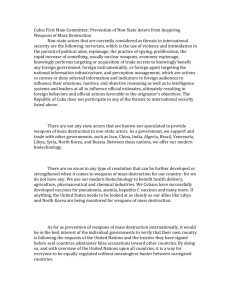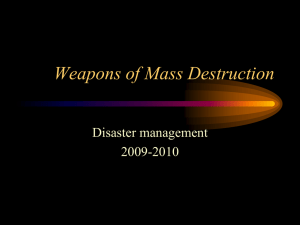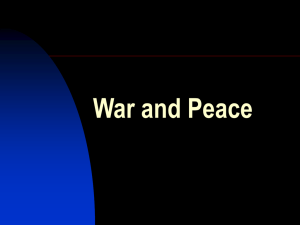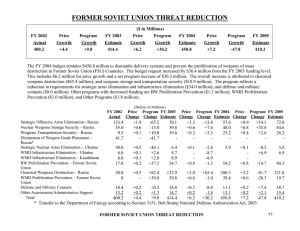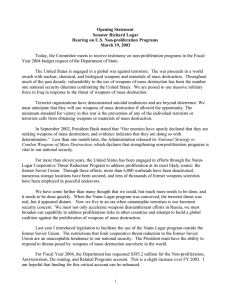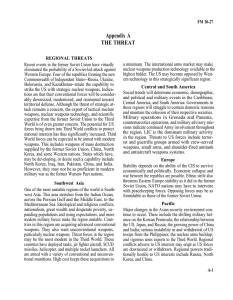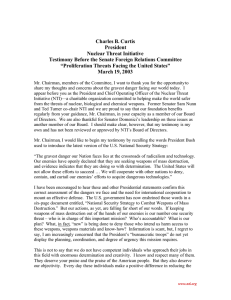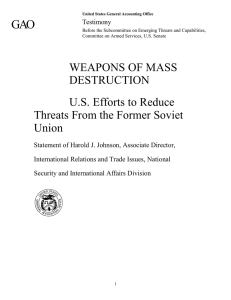TESTIMONY BEFORE THE EMERGING THREATS AND CAPABILITIES SUBCOMMITTEE OF
advertisement
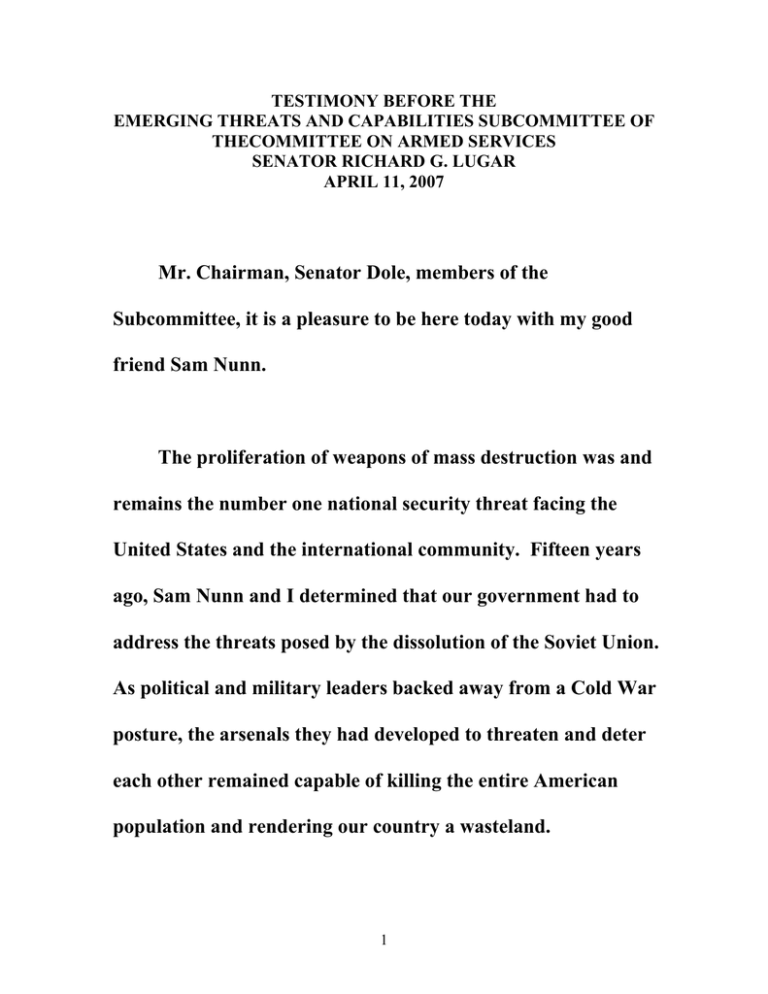
TESTIMONY BEFORE THE EMERGING THREATS AND CAPABILITIES SUBCOMMITTEE OF THECOMMITTEE ON ARMED SERVICES SENATOR RICHARD G. LUGAR APRIL 11, 2007 Mr. Chairman, Senator Dole, members of the Subcommittee, it is a pleasure to be here today with my good friend Sam Nunn. The proliferation of weapons of mass destruction was and remains the number one national security threat facing the United States and the international community. Fifteen years ago, Sam Nunn and I determined that our government had to address the threats posed by the dissolution of the Soviet Union. As political and military leaders backed away from a Cold War posture, the arsenals they had developed to threaten and deter each other remained capable of killing the entire American population and rendering our country a wasteland. 1 After the fall of the Soviet Union, the new nations of Ukraine, Belarus, and Kazakhstan emerged as the third, fourth and eighth largest nuclear powers in the world. Amidst disarray in the Soviet political system and threats from Moscow, Kiev, Minsk, and Almaty debated whether they should remain nuclear powers or abandon the costly and dangerous Soviet-made weapons systems. Sam and I challenged the United States and our former enemies to work together on a programmatic response to the threat. The Nunn-Lugar Program was the answer. The program helped convince the three new nuclear powers to remove all of the nuclear weapons from their territory. In addition, it became the primary tool through which the United States would work with Russia to destroy its massive nuclear, chemical, and biological warfare capacity. 2 I have with me today the Nunn-Lugar scorecard. My office systematically tracks the elimination of each warhead, missile, bomber, and submarine. To date, the program has destroyed more weapons than the combined arsenals of the United Kingdom, France, and China. The successes notated on these charts were never a foregone conclusion. Even after fifteen years, creativity and constant vigilance are required to ensure that the Nunn-Lugar program is not encumbered by bureaucratic obstacles, starved by inadequate funding, or undercut by political disagreements. Through the ups and downs of the U.S.-Russian relationship, the Nunn-Lugar Program has been a constant. Today, while bilateral relations are strained in other areas, the program continues to do its important work. But we still have a lot of work to do in the former Soviet Union. 3 Mr. Chairman, Sam and I could relate story after story accumulated over 15 years as we watched the process of safeguarding and destroying these weapons proceed. But these successful efforts still face two challenges. First, we continue to complicate our own efforts to destroy weapons of mass destruction through self-imposed bureaucratic red tape. Second, more resources are needed to capitalize on opportunities to advance the threat reduction process. CERTIFICATIONS: In 1991, concerns surrounding Russian intent led some members to include in the original Nunn-Lugar legislation a requirement that the President certify annually that each recipient is “committed to” meeting six conditions. While well intentioned, these certification requirements have sometimes delayed or complicated efforts to destroy weapons of mass destruction. In some years, more than half the fiscal year passed 4 before the certification process was completed. This restricted Nunn-Lugar funds and delayed some weapons dismantlement projects for months. The certifications also have wasted hundreds of man-hours. Instead of interdicting WMD shipments or identifying the next AQ Khan, our nonproliferation experts spend time assembling certification or waiver determinations. The certification requirements are counterintuitive because they imply that the value of Nunn-Lugar activities diminishes when our differences with Moscow are amplified. In my judgment, the opposite is true. The benefits of verifiable destruction of WMD in Russia and of steady Nunn-Lugar contacts become even more valuable when other aspects of the U.S.-Russian relationship are experiencing friction. The bottom line is that safeguarding and eliminating weapons of mass destruction in cooperation with a willing government will almost always be in the national security interest of the United States, 5 and the burden of proof should be on those who believe otherwise. The Senate agrees with this proposition. In 2005, the Senate approved an amendment I offered to eliminate these certification requirements by a 78 to 19 vote. Last year, the Senate adopted a similar amendment by unanimous consent. Unfortunately, these provisions were not included in the relevant conference agreements. I am pleased that Secretary Rice and National Security Advisor Hadley have endorsed my efforts. I have, again, introduced this legislation and urge the Armed Services Committee to adopt it and serve as a strong advocate during conference with the House. FUNDS: The second major impediment to the Nunn-Lugar Program realizing its full potential is money. While not the subject of as 6 many cinematic thrillers, the threat posed by the proliferation of deadly pathogens rivals the more popularized “loose nuke” threat. A large number of pathogens and disease strains remain scattered in various locations, often with poor security. Without a substantial funding increase, important biological projects will go unfunded and dangerous pathogens such as anthrax, plague, smallpox, hemorrhagic fever, and avian influenza will be left unprotected and vulnerable to theft or diversion. I have written to Chairman Levin and Senator McCain urging them to add $100 million to the program’s budget to respond to these threats. With these funds, we could begin projects in seven additional countries. Under the current funding request, no work will get underway in those countries for years. A $100 million investment is a small amount when compared to 7 the deaths and economic costs that could result from a biological weapons attack, pathogen outbreak, or disease pandemic THE FUTURE: Mr. Chairman, while the program continues its important work addressing threats in the former Soviet Union, new challenges are emerging. The world has watched closely as the Six Power Talks on North Korea’s nuclear weapons program have proceeded. Ambassador Chris Hill still has difficult diplomatic spade work ahead, but we must begin to plan for the next step. If negotiations yield an agreement with Pyongyang to eliminate its weapons of mass destruction and their means of delivery, the Nunn-Lugar program has ready expertise to do this work. It will not be the only program employed, but it is a unique tool that must be available to the President. 8 In 2003, Congress approved and the President signed the Nunn-Lugar Expansion Act. It authorized $50 million in NunnLugar funding to be used outside the former Soviet Union. This authority has already been put to use in Albania, where a new government turned to the U.S. to help deal with the previous government’s secret: sixteen tons of chemical weapons stored under minimal security. The Albanian experience reinforced that the Nunn-Lugar program should have the flexibility to adjust to unforeseen contingencies. We should remove the $50 million limit on work outside the former Soviet Union. We should also give the Secretary of Defense the authority to implement Nunn-Lugar projects in difficult political and strategic environments without the risk that operations could be suspended because of unintended consequences of executive or legislative action. 9 Today, the $30 million Nonproliferation and Disarmament Fund at the Department of State is the only U.S. nonproliferation program that operates with so-called “Notwithstanding Authority.” The Nunn-Lugar program should have similar flexibility. This authority would not preclude a Congressional decision to adjust or limit the Nunn-Lugar program’s work in given cases. But we should ensure that the potential for NunnLugar work is not circumscribed unintentionally. Mr. Chairman, the Nunn-Lugar Program’s track record is impressive. Sam and I have traveled with the program’s experts extensively. They are committed, as we are, to protecting this country. We must continue to find ways to help them do their job better and reduce the burdens we impose upon them. Governments around the world are seeking our assistance with dangerous weapons issues. For example, the program could provide assistance to nations in Southeast Asia to secure 10 pathogens and viruses. The secret chemical stockpile in Albania will not be the last WMD that is discovered. We must be prepared to go anywhere in the world, at any time, with the resources necessary to eliminate the threat. Over the years, I have described Nunn-Lugar work to address threats posed by weapons of mass destruction as a “window of opportunity.” We never know how long that window will remain open. We should not let any opportunity pass to reduce the number of nuclear warheads or to enhance our verification regimes. Our government has the expertise and the capabilities to dramatically benefit the country’s security. We must ensure that we have the political will and the resources to implement programs devoted to these ends. Thank you. ### 11 12

